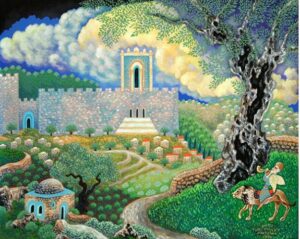בס”ד
By Rabbi Moshe Goodman, Kollel Ohr Shlomo, Hebron

This parsha describes the Temple Mount as the “gate of the heavens.” This painting seems to depict this
theme– (there is a more updated version of this painting). We see a winged man riding on a lion,
sounding the shofar. This figure seems to indicate the Mashiach, since the wings seem to hint to an
angelic/saintly status. Also the shofar is mentioned in verses as a symbol of redemption. The lion may hint
to royalty, as Mashiach is considered a king, or the tribe of Judah from which Mashiach ben David is said
to come from. There is also a miracle told about Rabbi Efraim Ankaveh, who kept the Shabbat in the
desert despite the abandonment of the traveling group he was a member. At the end of Shabbat a lion
approached him and summoned him to ride on its back. Rabbi Ankaveh indeed rode on the lion, and the
lion quickly ran and brought Rabbi Ankaveh back to his traveling group, astonished by his miraculous
arrival. Thus, Hashem’s Name was sanctified and the honor of Shabbat glorified before all. In a similar
way it seems that this image suggests the sanctification of Hashem’s Name through the figure of
Mashiach.
Adjacent to the Temple we see seven cypresses, the special Jewish number found in many of R’
Nachshon’s paintings. These seven cypruses lead up to the Temple, and they may allude to the seven years
King David, considered the forerunner of Mashiach, ruled in Hebron. In this way, Hebron can be seen as
pivotal in the building of Jerusalem, the Temple, and the advent of Mashiach.



